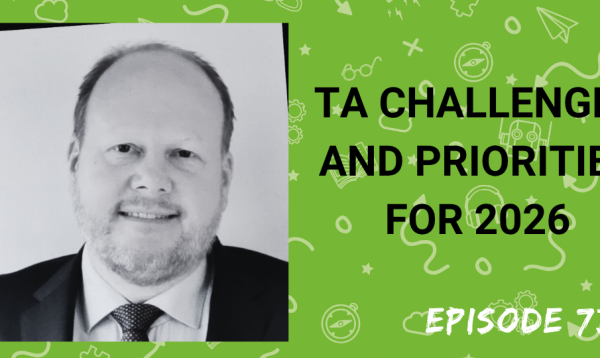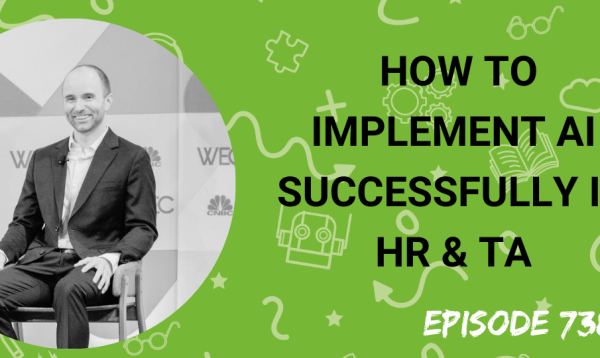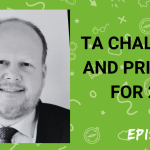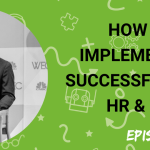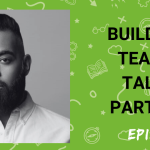Back in May, I spoke to author Scott Berkun about Design Thinking, and we touched on some of the ways it can be used in talent acquisition. I now wanted to dig a bit deeper into some of the practicalities of this and explore the value that design thinking can bring to recruiting.
My guest this week is Jodi Brandstetter, talent strategy consultant and author of the book Hire By Design. Jodi has previously worked as a Director of Talent Acquisition and has some great experience of applying design thinking to recruiting challenges.
In the interview, we discuss:
▪ The current state of the market
▪ What is design thinking?
▪ How can design thinking be applied to talent acquisition?
▪ The importance of empathy
▪ Improving the candidate experience
▪ Journey mapping
▪ The role of technology
▪ What should talent acquisition leaders be doing now to prepare for the future
Subscribe to this podcast in Apple Podcasts
Transcript:
Matt Alder [00:00:00]:
Support for this podcast comes from Eightfold AI. Eightfold AI delivers the talent Intelligence platform, the most effective way for companies to retain top performers, upskill and reskill the workforce, recruit top talent efficiently, and reach diversity goals. Eightfold AI’s deep learning artificial intelligence platform empowers enterprises to turn talent management into into a competitive advantage.
Matt Alder [00:00:47]:
Hi everyone, this is Matt Alder. Welcome to episode 318 of the Recruiting Future podcast. Back in May, I spoke to author Scott Birkin about design thinking and we touched on some of the ways it could be used in talent acquisition. I now want to dig a bit deeper into some of the practicalities of this and explore the value that design thinking can bring to recruiting. My guest this week is Jodi Brandstetter, talent strategy consultant and author of the book Hire by Design. Jody has previously worked as a director of Talent Acquisition and has some great experience of applying design thinking to recruiting challenges. Hi Jody and welcome to the podcast.
Jodi Brandstetter [00:01:36]:
Hi. So good to be here.
Matt Alder [00:01:38]:
An absolute pleasure to have you on the show. Could you just introduce yourself and tell us what you do?
Jodi Brandstetter [00:01:44]:
Absolutely. I’m Jodi Brandstetter and I’m the chief talent strategist for Lean Effective Talent Strategies. We focus on providing consulting, training and education around talent acquisition and design thinking. We have two divisions, the Hiring Blueprint and that’s where we specialize in the talent acquisition and design thinking consulting for small to mid sized companies in the US and then we have our Talent Acquisition Evolution division which is a community for talent acquisition and recruiting professionals where we network, connect and learn together. And. And I also just got to add author to my title, which is really exciting. I just published my book Hire by Design, a Hiring Blueprint with Design Thinking in September of this year.
Matt Alder [00:02:29]:
Tell us a bit more about you. Tell us a bit more about your backstory and how you got to do what you do now.
Jodi Brandstetter [00:02:33]:
Absolutely. So I have been in talent acquisition for about 20 years, right out of college and I’ve been. I live in Cincinnati, Ohio and pretty much my whole career has been in Cincinnati and I’ve worked in the corporate side as well as on the staffing side. And then in 2018 is when I decided to jump ship from corporate and move on and become an entrepreneur and start my own business.
Matt Alder [00:02:58]:
I want to talk about design thinking in detail in a second, particularly how it can apply to talent acquisition. Before we do though, give us your perspective on what’s been happening in talent acquisition as far as you see it, during 2020.
Jodi Brandstetter [00:03:13]:
2020 has been just a very interesting, crazy year for us with the pandemic and then with the social unrest that’s happened, you know, throughout the country as well as the world. I think with talent acquisition, there’s been really kind of two pieces that we can really look at as far as evolution within our industry. First off is, you know, recognizing that when we have a shift, we have a change within the economy or with the pandemic. Recruiting does need to continue, but it might continue in a different way. So being able to move forward in a new way. So if that is, you know, possibly slowing down recruiting and building your employer brand and keeping you kind of in the world, in the, you know, in the recruiting world in some fashion, or you have the other side where people are just going crazy with hiring, with health care, with retail, and really being able to find new ways to recruit and attract talent without maybe being in person. So there’s been a lot of changes that I think are good in some ways. I think we’ve started to use technology in a better way, more focused on making it work for us, I guess, within the TA world. And then with the social unrest, you know, I think that a lot of us have been thinking about what’s happened, how can we be a part of it. And as recruiters, I think there’s a lot that we can do with focusing on taking bias out of the recruiting area, ensuring that our companies are standing for what they believe and being able to communicate that to our candidates out to the public and do what’s right with what we need to be doing today.
Matt Alder [00:05:06]:
Let’s talk about a bit more about design thinking. I suppose the best place to start is for people who might not be familiar with the term. What is design thinking?
Jodi Brandstetter [00:05:15]:
Sure. So it’s a methodology that really focuses on ensuring that a product, a service, an experience, is focused on the person who’s actually going to be using or being a part of that service or that experience, but then also focus on the business, making sure it’s feasible, scalable and viable. So it really is trying to ensure that a service, and I’ll just go with service, is something that’s going to work well for the person, but also work well for the business. And then it uses specific steps to ensure that’s going to happen. And then it also focuses on constantly iterating, so constantly improving that process, understanding that people shift, people change, economies change, obviously, businesses change. So you have to be able to change with it.
Matt Alder [00:06:10]:
And how do you apply that to talent acquisition?
Jodi Brandstetter [00:06:13]:
When I started my consulting business, I was really trying to find a way to set myself apart as a consultant and I knew methodology could really help me with that. And so we, you know, obviously in talent acquisition there’s not really a methodology that we learn that kind of helps us with providing better process and experience. So I started researching and design thinking just kind of seemed like a no brainer. You know, it helps us focus on the person. Right. So as a recruiter, you are trying to find individuals that will work well in your company. And the reason we’re looking for people to work in our company is because we have a business case for that. Right. So understanding the business case and then being able to find the right person, it really is design thinking in its own kind of way. So if you can develop experiences and processes that are focused on the candidate, focus on the people in the situation, in the whole strategy of talent acquisition and then ensure that it meets what the business is looking for, it kind of, you know, really works well. And design thinking really focuses on a human mindset and focuses on empathy. And I really truly believe that talent acquisition needs to make sure they’re, they’re thinking about empathy when they’re creating these experiences, these processes and what they put a candidate through.
Matt Alder [00:07:46]:
I was just going to say that’s critical in the, in the candidate experience, I guess very critical in the candidate experience at the moment. When companies are recruiting virtually and doing things they’ve not done before and maybe not considering how the candidate is experiencing that. Tell us a bit more about that. How could design thinking be used sort of specifically to improve candidate experiences?
Jodi Brandstetter [00:08:10]:
Absolutely. So with candidate experience, it’s a journey, right? They start with somehow finding out about the company or the opportunity. They then review that opportunity, make a decision if they want to move forward and apply or talk to a recruiter or learn more about the position, and then they start the interview process or the selection process. With design thinking, what you can do is first map out, do a journey map of what that candidate does from start to finish. So from being sourced as a passive candidate or being an active candidate and finding the role on a job board, for example, to onboarding and you can walk through that candidate journey and be able to see are there any bottlenecks, are there any areas that we can improve the experience and then be able to take ideation, be able to brainstorm to come up with solutions to those bottlenecks or those challenges. So if it’s you Know, for example, your application isn’t ideal for someone to do. So I hear candidates all the time complaining about having to download their resume and then they have to type in their work history into an application, and it’s really annoying. It’s very frustrating for them. So that could be one challenge is how can we improve that experience for a candidate when they’re going through that application piece? Brainstorm some ideas, come up with, you know, we had that parsing as an option. It could be, I don’t know, a robot does it for them. I mean, you can really go crazy with your ideas with brainstorming, but then you can then take those ideas, test them out, see if it’s going to work, and then being able to kind of update that journey for the candidate and create a new blueprint on what a candidate experiences. And that could be with technology. So your technology might need to be updated. It could be with additional training because you’re hiring managers and the interviews are not clicking, you’re not getting the right results to your marketing. Are you actually looking at that candidate Persona, that ideal candidate at the beginning? So you’re really able to kind of look at each step of the journey or that process and then be able to come up with better solutions, innovative ideas, to be able to solve some of those challenges that you’re seeing.
Matt Alder [00:10:57]:
I think it’s really interesting because when we talk about it like this, it seems really obvious, but so many companies don’t do it, and there are so many sort of bad processes and bad candidate experiences out there. And I suppose the interesting thing for me is earlier in the year, I got to speak to the author, Scott Birkin, who’s got a book out about design thinking. And his background isn’t in talent acquisition, but when I asked him about how you could apply design thinking to talent acquisition, he just came up with loads of examples of bad candidate experiences that he’d had and how design thinking could fix them. Very much in the way that you’ve just said, why don’t companies do this in your experience? Why don’t they take these steps to empathize and understand what their candidates are going through?
Jodi Brandstetter [00:11:43]:
I think there’s a couple different reasons. You know, a lot of times the talent acquisition team is actually the HR team, and they have all these different responsibilities, and they just really don’t have the time to be able to sit down and really take, you know, look at a process, look at a journey of a candidate and be able to see what’s going on. You know, a lot of times. It’s the. We’ve always done it this way and this is how we’re going to do it. So they’re not willing to shift or to take that process and improve it. The other pieces with design thinking is there’s a lot of testing and there’s a lot of failure. Companies do not like to fail and they don’t like to test. They like to implement and go and just keep moving forward. And I think that’s something that companies have to really start looking at is, you know, how can they ensure that they can test and iterate and continue to improve as well as be okay with failure and being able to learn from that failure. So I think there’s a couple different ways. And then also we talk about candidate experience a lot. And actually in my book, I actually call it people experience because there’s two groups of people that we never talk about their experience, and that’s the recruiter and the hiring manager. And they’re people too. And their experience is very important in this process too. If you have a recruiter that’s not happy, they’re not going to do a great job recruiting for you. If you have a hiring manager that doesn’t understand the process or can’t trust a recruiter or trust what’s going on, that’s going to make that experience for them negative as well. So I think that when you’re looking at candidate experience, you also have to recognize you have to look at every person’s experience during that journey, which would include the recruiter, the hiring manager, the interviewers who are helping interview your candidates. You have to think about the candidate’s family. You know, they always say, happy wife, happy life. Right. Well, if the wife or partner or whoever is not happy with this company, they’re not going to pick you. So you have to really make sure you’re thinking about everyone. That’s really a part of this process.
Matt Alder [00:14:03]:
You mentioned technology there. How can design thinking and recruiting sort of technology meet and, and make things more effective for people?
Jodi Brandstetter [00:14:12]:
Yeah. So technology should be a part of the recruiter. So you need to look at technology as a way to enhance the experience for a recruiter, the hiring manager and the candidate. You don’t want technology to hurt the whole process. So having it almost be an extension to, you know, whoever is providing that service or that experience is really key. So technology is one of the key areas. Design thinking really works well. So if you’re looking at a talent technology company, ensuring that they’re looking at that design of how that technology is going to flow. And a lot of times we, the recruiters are the ones that ruin the technology because we try to do these different shortcuts or we ask them to add pieces or change pieces and that’s when technology really becomes clunky. So again, it’s really making sure that that piece of technology, if it’s an applicant tracking system, a pre employment assessment video interviewing, that you’re really it in the way it’s supposed to be used. And that really is coming back to the TA technology company to make sure they’re, they’re creating technology that really is going to help the process, not hinder the process.
Matt Alder [00:15:39]:
So what this year has proved is it is impossible to predict the future. So rather than asking you to sort of predict what’s going to happen in talent acquisition in sort of 2021, 2022, instead, what would your advice be to talent acquisition leaders of what they should be doing right now to prepare for the future?
Jodi Brandstetter [00:16:01]:
I think leaders need to ensure that they have a strong team in place for a successful change in the economy. So if we go from where we’re at today, where a lot of companies aren’t hiring as much, do they have the team in place so that when everything shifts and we’re back to that candidate market again, do they have the team that’s really going to be successful? So this is a time for them to be looking at who’s on their team, what technology is a part of their team, what have they changed this year that can actually enhance the experience and the process moving forward? What are areas that they had to change because of the circumstances that they would want to change back or even try something brand new. So they really have to be looking at their team, their strategy and being able to come up with a way that they can be innovative, a way that they can think outside the box, test out opportunities while still being able to continue that recruiting cycle. So if that’s selecting project teams within your group to investigate other options or opportunities that they should be looking at, to working with consultants who can come in and, you know, really do a deep dive in their talent acquisition team process experience and be able to provide them with kind of what is working, what’s not working, and give them some really good information as far as what, you know, what they can really enhance. And then I would also be looking at analytics and metrics. What are those key metrics that you can really focus on to help improve your team and to also improve the hiring that they’re doing. So I think it’s a lot of just honing in on their specialty and really kind of becoming even more of an expert. So continuing to learn, continuing to give opportunities for their team to learn and to be able to try things out.
Matt Alder [00:18:25]:
Final question, where can people find you and where can they find your book?
Jodi Brandstetter [00:18:29]:
You can find me on LinkedIn so I am on LinkedIn. It’s Jodi J O D I Brandstetter, which is a super long last name. So B R A N D S T E T T E R I’m also I have a website for my book that you can go to that has free templates to help with putting design thinking into your process as well as some talent acquisition templates as well. And the website is hirebydesignbook.com that’s hiredbydesignbook book.com and they can always email me at Dodie J O d I at let’s L E T S Cincy CN CinCin Y.com Jodie thank you very much.
Matt Alder [00:19:16]:
For talking to me.
Jodi Brandstetter [00:19:17]:
Thank you.
Matt Alder [00:19:19]:
My thanks to Jody. You can subscribe to this podcast in Apple Podcasts on Spotify or via your podcasting app of choice. Please also follow us on Instagram. You can find the show by searching for Recruiting Future. You can search through all the past episodes@recruiting future.com on that site. You can also subscribe to the mailing list to get the inside track about everything that’s coming up on the show. Thanks very much for listening. I’ll be back next time and I hope you’ll join me.


